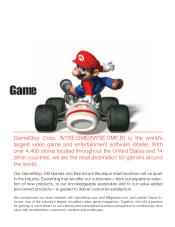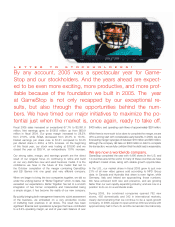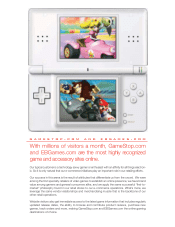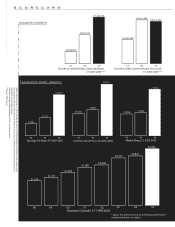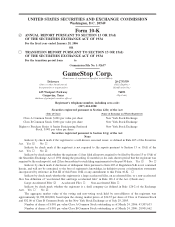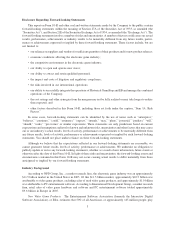GameStop 2005 Annual Report Download - page 13
Download and view the complete annual report
Please find page 13 of the 2005 GameStop annual report below. You can navigate through the pages in the report by either clicking on the pages listed below, or by using the keyword search tool below to find specific information within the annual report.video or computer games on a regular basis. We expect the following trends to result in increased sales of video
game products:
•Hardware Platform Technology Evolution. Video game hardware has evolved significantly from the
early products launched in the 1980s. The processing speed of video game hardware has increased from
8-bit speeds in the 1980s to 128-bit speeds in next-generation systems such as Sony PlayStation 2, launched
in 2000, and Nintendo GameCube and Microsoft Xbox, which both launched in November 2001. In
addition, portable handheld video game devices have evolved from the 8-bit Nintendo Game Boy to the
128-bit Nintendo DS, which was introduced in November 2004, and the Sony PSP, which was introduced in
March 2005. Microsoft released the Xbox 360 in November 2005 and Sony and Nintendo are each expected
to release their respective new consoles in late 2006. Technological developments in both chip processing
speed and data storage have provided significant improvements in advanced graphics and audio quality,
which allow software developers to create more advanced games, encourage existing players to upgrade
their hardware platforms and attract new video game players to purchase an initial system. As general
computer technology advances, we expect video game technology to make similar advances.
•Next-Generation Systems Provide Multiple Capabilities Beyond Gaming. Many next-generation hardware
platforms, including Sony PlayStation 2 and Microsoft Xbox and Xbox 360, utilize a DVD software format
and have the potential to serve as multi-purpose entertainment centers by doubling as a player for DVD
movies and compact discs. In addition, Sony PlayStation 2, Nintendo DS and Microsoft Xbox and Xbox 360
manufacture accessories which provide internet connectivity.
•Backward Compatibility. Sony PlayStation 2, Nintendo DS and, to some extent, Microsoft Xbox 360 are
backward compatible, meaning that titles produced for the earlier version of the hardware platform may be
used on the new hardware platform. We believe that backward compatibility may result in more stable
industry growth because the decrease in consumer demand for products associated with existing hardware
platforms that typically precedes the release of next-generation hardware platforms may be diminished.
•Introduction of Next-Generation Hardware Platforms Drives Software Demand. Sales of video game
software generally increase as next-generation platforms mature and gain wider acceptance. Historically,
when a new platform is released, a limited number of compatible game titles are immediately available, but
the selection grows rapidly as manufacturers and third-party publishers develop and release game titles for
that new platform. For example, when Sony PSP was released in March 2005, approximately 20 game titles
were available for sale. Currently, there are over 200 titles for the Sony PSP platform available for sale.
•Broadening Demographic Appeal. While the typical electronic game enthusiast is male between the ages
of 14 and 35, the electronic game industry is broadening its appeal. More females are playing electronic
video games, in part due to the development of video game products that appeal to them. According to ESA,
approximately 43% of all electronic game players are female. More adults are also playing video games as a
portion of the population that played video games in their childhood continues to play and advance to the
next-generation video game products. In addition, the availability of used video game products for sale has
enabled a lower-economic demographic, that may not have been able to afford the considerably more
expensive new video game products, to participate in the video game industry.
Used Video Game Market. As the installed base of video game hardware platforms has increased and new
hardware platforms are introduced, a growing used video game market has evolved in the United States. Based on
reports published by NPD, we believe that, as of December 2005, the installed base of video game hardware systems
in the United States, based on original sales, totaled over 200 million units, including approximately 600,000
Microsoft Xbox 360 units, 3.6 million Sony PSP units, 33 million Sony PlayStation 2 units, 14 million Microsoft
Xbox units, 11 million Nintendo GameCube units, 32 million Nintendo DS, Game Boy Advance SP and Game Boy
Advance units, 29 million Sony PlayStation units and over 80 million units of older hardware platforms such as
Sega Dreamcast, Nintendo 64, Nintendo Game Boy and Game Boy Color, Sega Genesis and Super Nintendo
systems. Hardware manufacturers and third-party software publishers have produced a wide variety of software
titles for each of these hardware platforms. Based on internal company estimates, we believe that the installed base
of video game software units in the United States exceeds 800 million units.
4


